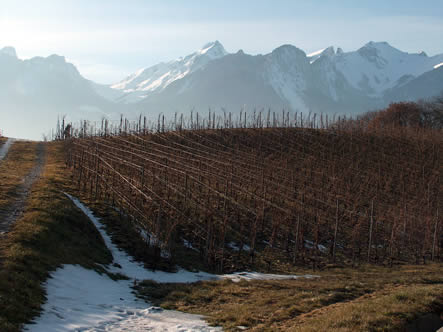|
What
to drink
at Christmas
 This is the time of year when winewriters traditionally
agonize over which wines go best with turkey (or goose if you are posh
and innovative) or the various alternatives. Or else they trot out
rather cliched lists containing white Burgundy, mature Claret and
Port. Itís all a bit boring, and I donít intend to go the same
way. Instead, hereís my rather eclectic list of wines that I think
will brighten up the festive season, through their personality, or
intrinsic quality, or by virtue of being great value for money. This is the time of year when winewriters traditionally
agonize over which wines go best with turkey (or goose if you are posh
and innovative) or the various alternatives. Or else they trot out
rather cliched lists containing white Burgundy, mature Claret and
Port. Itís all a bit boring, and I donít intend to go the same
way. Instead, hereís my rather eclectic list of wines that I think
will brighten up the festive season, through their personality, or
intrinsic quality, or by virtue of being great value for money.
1. Fizz. Fizz is great any time, but
particularly so when you are celebrating. But we are so limited in our
imagination when it comes to serving it. Donít just give guests a
glass as an apertif, or for toasting. Why not serve it through the
meal? Fizz is remarkably food friendly Ė and itís versatile, too.
Itís best to have a variety of fizzes so you can
match the occasion. In absolute quality terms, thereís nothing quite
like Champagne, and I reckon these days the average quality of even
cheap Champagnes is pretty good. New world fizz can be superb, but it
doesnít tend to have quite the same flavour profile as Champagne.
Having said this, few people can differentiate quality in sparkling
wines very effectively, and thereís certainly a place in your
Christmas wine stash for inexpensive fizz such as Cava and the more
basic new world offerings. These have the added benefit of being
fruitier and more accessible than most Champagnes, so they go down
well with non-wine-geek guests. If you are feeling flush or itís a
special meal then really good Champagne canít be beaten: my
favourites include Roederer, Pol Roger, Laurent Perrier and Taittinger.
2. Wines from the Southwest of France. Dudes,
the southwest of France is making some of the most interesting,
character-filled reds you could possibly hope for, at prices that make
it seem like Christmas. [Well, I guess it will be Christmas when you
are drinking these.] The problem is getting hold of them, because they
donít find their way onto supermarket shelves. Marcillac, Gaillac, Madiran, Coteaux du Quercy, Cahors and
Irouleguy. These
are the names to look for. Best source: Les Caves de Pyrene in
Guildford, which has a brilliant list. A mail order mixed case from
Les Caves should see you sorted for a while.
3. Wines from the Loire. The Loire valley of
France makes some fantastic wines, and compared with the likes of
Burgundy and Bordeaux, they are pretty well priced. Steer clear of
Sancerre and Pouilly-Fume (just Sauvignon, thatís all they are), and
look out for Anjou reds and whites, Vouvray (sec is dry, Moelleux is
sweeter Ė itís Chenin, an interesting grape), Samur Champigny,
Chinon and Bourgeuil. Biodynamic and organic growers often make more
interesting Loire wines. Good Loire wines are hard to get hold of, but
worth the effort. Best source Les Caves de Pyrene (above), RSJ, Berry
Bros & Rudd.
4. Affordable Australian wines. Aussie wines
have taken a bit of a critical bashing recently for being boring and
industrial. I still like them, and Iíve recently enjoyed some really
nice fruit-filled reds that arenít too jammy or sweet, and which
arenít beaten into submission by loads of oak. I like the St
Halletts Gamekeepers Red (Oddbins, Waitrose, Thresher, Sainsbury among
others), anything by Ben Glaetzer (Heartland, Mitolo and Glaetzer,
carried by Oddbins) and even the in-yer-face Zontes Footstep Shiraz
Viognier (Sainsbury).
5. Sweet wines. We should be drinking more
Sauternes, more Port, more Sherry (although most of these arenít
really sweet) and more Madeira (ditto). Just do it.
6. Portuguese wines. Particularly those from the
Douro and Alentejo. Theyíre just a bit different, and I really like
them. Like many interesting wines, itís hard to locate the good
stuff from Portugal, which rarely gets a look in on supermarket
shelves. Waitrose has an OK selection, but otherwise itís
independent wine merchant territory. Avoid anything by DFJ Ė to me,
these wines taste a bit similar and rather spoofy.
7. GrŁner Veltliner.
It rocks. Austriaís own white grape variety can make wines that
range from bright and fresh (if a little neutral), to those that are
richer with a lovely peppery freshness, to those which are
concentrated, complex, off-dry and spicy. Great for Christmas
drinking. Look out for FX Pichler, Brundlmayer, Schloss Gobelsberg,
Kurt Angerer, Emmerich Knoll, Rudi Pichler, Fred Loimer, Jurschitsch
and Stadt Krems.
What I wonít be drinking:
Chilean reds. Very repetitious. Lots of sweet
fruit with a strong green streak in the background. A bit boring
really.
Cheap South African reds. Again, greenness is
almost always a problem with these wines. It makes them taste angular
and rustic, but not in a nice way (rustic can be good in certain
contexts).
Cheap Californian wines. California makes some
great wines, but seems to me to have a staggering inability to make
palatable cheap stuff. Iíd rather drink water than the likes of
Blossom Hill. I wouldnít call being Californian and affordable a
Ďwine faultí, but itís getting close.
Supermarket wines, listed at £7.99 and bottled in
the UK (usually wine at this price is bottled at source), and then
being sold at half price in gondola end promotions.
Back to top
|

